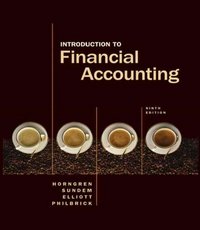Answered step by step
Verified Expert Solution
Question
1 Approved Answer
1) On August 31, Jenks Co. partially refunded $180,000 of its outstanding 10% note payable, made one year ago to Arma State Bank by paying
1) On August 31, Jenks Co. partially refunded $180,000 of its outstanding 10% note payable, made one year ago to Arma State Bank by paying $180,000 plus $18,000 interest, having obtained the $198,000 by using $52,400 cash and signing a new one-year $160,000 note discounted at 9% by the bank. 1) Make the entry to record the partial refunding. Assume Jenks Co. makes reversing entries when appropriate. (2) Prepare the adjusting entry at December 31, assuming straight-line amortization of the discount. 2). Prepare journal entries to record the following retirement. (Show computations and round to the nearest dollar.) The December 31, 2010 balance sheet of Wolfe Co. included the following items: 7.5% bonds payable due December 31, 2018 $1,200,000 Unamortized discount on bonds payable 48,000 The bonds were issued on December 31, 2008 at 95, with interest payable on June 30 and December 31. (Use straight-line amortization.) On April 1, 2011, Wolfe retired $240,000 of these bonds at 101 plus accrued interest. 3. (TCO E) Parker Corporation has issued 2,000 shares of common stock and 400 shares of preferred stock for a lump sum of $72,000 cash. Instructions (a) Give the entry for the issuance assuming the par value of the common was $5 and the market value $30, and the par value of the preferred was $40 and the market value $50. (Each valuation is on a per share basis and there are ready markets for each stock.) (b) Give the entry for the issuance assuming the same facts as (a) above except the preferred stock has no ready market value, and the common stock has a market value of $25 per share. 4) (TCO F) In each of the following independent cases, it is assumed that the corporation has $400,000 of 6% preferred stock and $1,600,000 of common stock outstanding, each having a par value of $10. No dividends have been declared for 2009 and 2010. (a) As of 12/31/11, it is desired to distribute $250,000 in dividends. How much will the preferred stockholders receive if their stock is cumulative and nonparticipating? (b) As of 12/31/11, it is desired to distribute $400,000 in dividends. How much will the preferred stockholders receive if their stock is cumulative and participating up to 11% in total? (c) On 12/31/11, the preferred stockholders received a $120,000 dividend on their stock which is cumulative and fully participating. How much money was distributed in total for dividends during 2011? 5) . (TCO A) At December 31, 2010, Kifer Company had 500,000 shares of common stock outstanding. On October 1, 2011, an additional 100,000 shares of common stock were issued. In addition, Kifer had $10,000,000 of 6% convertible bonds outstanding at December 31, 2010, which are convertible into 225,000 shares of common stock. No bonds were converted into common stock in 2011. The net income for the year ended December 31, 2011, was $3,000,000. Assuming the income tax rate was 30%, what would be the diluted earnings per share for the year ended December 31, 2011 (rounded to the nearest penny)? Show all computations 6. (TCO B) On May 1, 2010, Kirmer Corp. purchased $450,000 of 12% bonds, interest payable on January 1 and July 1, for $422,800 plus accrued interest. The bonds mature on January 1, 2016. Amortization is recorded when interest is received by the straight-line method (by months and rounded to the nearest dollar). (Assume bonds are available for sale.) Instructions (a) Prepare the entry for May 1, 2010. (b) The bonds are sold on August 1, 2011 for $425,000 plus accrued interest. Prepare all entries required to properly record the sale
Step by Step Solution
There are 3 Steps involved in it
Step: 1

Get Instant Access to Expert-Tailored Solutions
See step-by-step solutions with expert insights and AI powered tools for academic success
Step: 2

Step: 3

Ace Your Homework with AI
Get the answers you need in no time with our AI-driven, step-by-step assistance
Get Started


